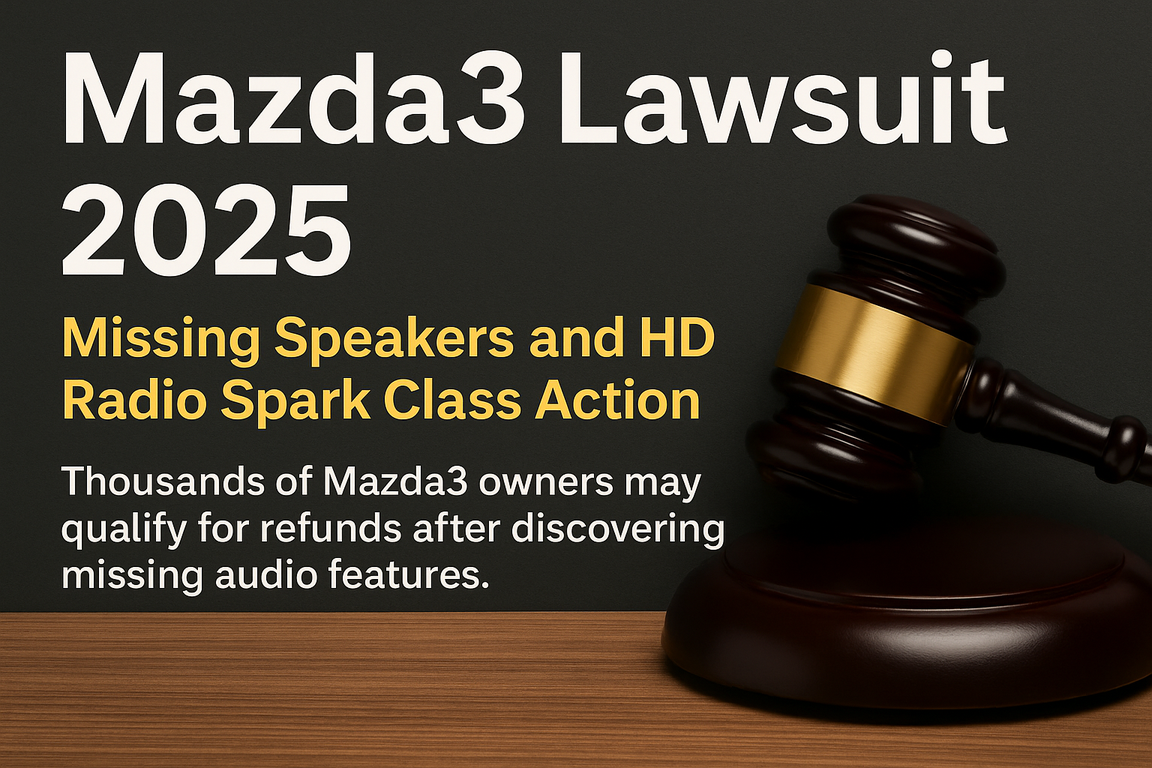The Mazda3 lawsuit filed in July 2025 claims Mazda misled consumers. Some buyers of the 2025 Mazda3 2.5 S models discovered their vehicles did not include the advertised audio features. The Monroney window sticker stated that these cars had eight speakers and HD Radio. In reality, the vehicles only had six speakers and no HD radio functionality.
The lawsuit says this misrepresentation violates consumer trust and marketing laws. Mazda quietly updated the online versions of the vehicle stickers after customer complaints. However, the company did not make public announcements, issue recalls, or refund buyers. Many customers purchased their cars based on the listed audio upgrades and now feel deceived. The case highlights false advertising, product mislabeling, and concealment.
Who Filed the Suit and What Happened?
A Mazda3 buyer from Illinois filed the class-action suit. He bought a 2025 Mazda3 2.5 S Hatchback in March. After the purchase, he explored the car’s audio system. He found it only had six speakers. He also noticed there was no HD radio. This contradicted the Monroney label on the car at the dealership.
The customer contacted the dealer. A sales manager confirmed that the sticker was wrong. Mazda later replaced the sticker quietly at that location. Around the same time, Mazda updated its website to show accurate information. These changes happened silently, without informing all buyers. The plaintiff claims Mazda tried to hide the mistake instead of fixing it publicly.
What Are the Allegations?
The Mazda3 lawsuit includes multiple serious allegations. Each claim points to false marketing and customer deception.
1. Misrepresented Features
Mazda advertised features that were not actually present in the vehicles. The Monroney label stated there were eight speakers. But the vehicle only had six. It also promised HD Radio. In reality, no HD radio option existed in the vehicle menus. Customers paid more expecting premium sound. They never received it.
2. Fraudulent Omissions
Mazda failed to warn buyers before the sale. Internal staff and dealership managers knew about the label error. However, no recall or public notification followed. Buyers had no way to learn about the missing features until after purchase. This omission affected buyer decisions and violated fairness.
3. Unfair and Deceptive Practices
The lawsuit says Mazda used misleading marketing. By listing better equipment, the company gained unfair advantage over competitors. Customers were misled into thinking they were getting a higher-end sound system. The result was economic harm. Buyers paid for features they never received.
4. Concealment and Quiet Correction
Mazda did not issue a public correction. Instead, the company changed the online versions of the vehicle labels. Dealerships replaced physical stickers only when buyers raised concerns. That pattern shows deliberate concealment. The lawsuit argues this behavior is not only deceptive but illegal.
Who Can Join the Class?
Anyone who bought or leased a 2025 Mazda3 2.5 S model may be eligible. The affected trims include:
- 2.5 S Sedan
- 2.5 S Hatchback
- 2.5 S Select Sport Sedan
- 2.5 S Select Sport Hatchback
- 2.5 S Preferred Sedan
- 2.5 S Preferred Hatchback
The key requirement is this: If the vehicle’s Monroney sticker listed eight speakers or HD radio, but the car had neither, the buyer qualifies. The class includes thousands of people across the U.S. Eligible members will receive notice if the court certifies the case.
How Does This Differ From Other Mazda Lawsuits?
Mazda has faced other lawsuits in recent years. But those cases targeted defects. This one focuses on marketing deception.
- One lawsuit addressed infotainment screen failures. It included frozen screens, reboot loops, and lost functionality. That case led to a settlement.
- Another lawsuit involved engine defects. Some Mazda models suffered coolant leaks and overheating. Those claims targeted engine design flaws.
This Mazda3 lawsuit is different. It focuses on sticker misrepresentation. It challenges how Mazda labeled its vehicles and informed buyers. This is about false advertising, not product failure.
Why Does It Matter Now?
Monroney stickers must be accurate. These are the labels customers rely on during vehicle purchases. The government requires that these labels show true features and specs. When they are wrong, buyers lose trust.
Mazda changed the labels quietly. It didn’t notify all affected buyers. That lack of transparency raises legal and ethical concerns. If Mazda is held accountable, the case could lead to stronger industry standards. Automakers may need to improve disclosure practices. Accurate labeling protects consumers and ensures fair competition.
What Happens Next?
Class Certification
Before the case proceeds, the court must approve class status. The plaintiff must prove the issue affected a large group in the same way. If successful, Mazda will be required to notify all affected customers.
Discovery Phase
Both parties will collect and exchange evidence. This includes emails, marketing materials, and dealer communications. Lawyers will review how the sticker mistake happened and what Mazda did in response.
Settlement or Trial
The case could end in a financial settlement. Mazda may agree to refund affected buyers or offer service upgrades. If not, the lawsuit goes to trial. The court will decide whether Mazda broke the law and how to compensate buyers.
Consumer Actions
If you own a 2025 Mazda3 2.5 S, do this:
- Take photos of your window sticker
- Check your sound system and radio options
- Keep dealer communications
These records could help support your claim.
Real Consumer Reactions
Many buyers feel cheated. They paid extra thinking their Mazda3 had premium audio. After delivery, they found out the features were missing. Some contacted dealers and received no help. Others said dealers admitted the mistake but refused refunds. Most were shocked to find Mazda updated the labels silently. The overall sentiment is frustration, anger, and disappointment.
In‑Depth: Legal Allegation Summary
This lawsuit includes four key legal claims:
- False advertising: Mazda claimed features that were not present.
- Deception by omission: Mazda did not inform buyers in advance.
- Unfair business practices: Buyers paid more under false assumptions.
- Deliberate concealment: Mazda fixed labels silently and denied public responsibility.
These actions break multiple consumer protection laws. The plaintiff seeks refunds, possible rescission, and public acknowledgment from Mazda.
FAQ – Mazda3 Lawsuit
Q: What is the Mazda3 lawsuit about?
The case claims Mazda advertised eight speakers and HD radio but delivered only six speakers and no HD radio in some 2025 Mazda3 cars.
Q: Which models are included?
The 2025 Mazda3 2.5 S trims: Sedan, Hatchback, Select Sport, and Preferred.
Q: Do I need to take action now?
No. If the court certifies the class, you’ll be notified if you qualify.
Q: How do I know if I qualify?
Check your original window sticker. If it says “8-Speaker Audio” or “HD Radio” but your car lacks those, you’re likely included.
Q: What will happen next in the case?
The court will review the claims, allow discovery, and may proceed to settlement or trial.
Q: Will Mazda fix the missing features?
Unlikely. Mazda has not offered repairs or upgrades. The lawsuit seeks refunds, not retrofits.
Q: Is this the same as the Mazda infotainment issue?
No. That was a different case involving software bugs. This lawsuit targets sticker misrepresentation.
Mazda Lawsuits Comparison Table
| Case | Years / Models | Issue | Status |
|---|---|---|---|
| Mazda3 Audio Feature Lawsuit | 2025 Mazda3 2.5 S Sedan, Hatch | Missing speakers, false HD radio claim | Filed July 2025 |
| Infotainment Software Settlement | 2014–2023 Mazda models | Glitches, screen freezes, boot loops | Settlement in progress |
| Engine Overheating Lawsuit | 2021–2024 models with 2.5T engine | Coolant leaks, engine damage | Ongoing |
Final Thoughts
This Mazda3 lawsuit highlights how small details can lead to major consequences. Buyers trusted Mazda’s sticker claims. They expected eight speakers and HD radio. They got less. Mazda never corrected the mistake publicly. It fixed labels silently. That raises questions about transparency.
Now the court will decide. A class action could help thousands of owners. Refunds, upgrades, or other forms of justice may follow. If you bought a 2025 Mazda3, review your car’s audio setup and original sticker. Keep all records. Stay alert for class notifications. In the end, this case reminds all automakers—truth matters.




